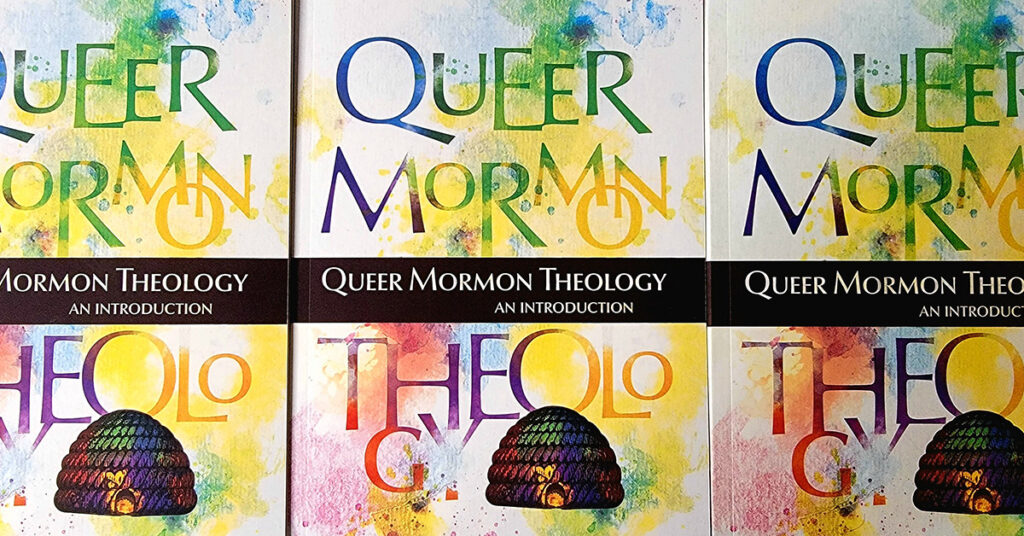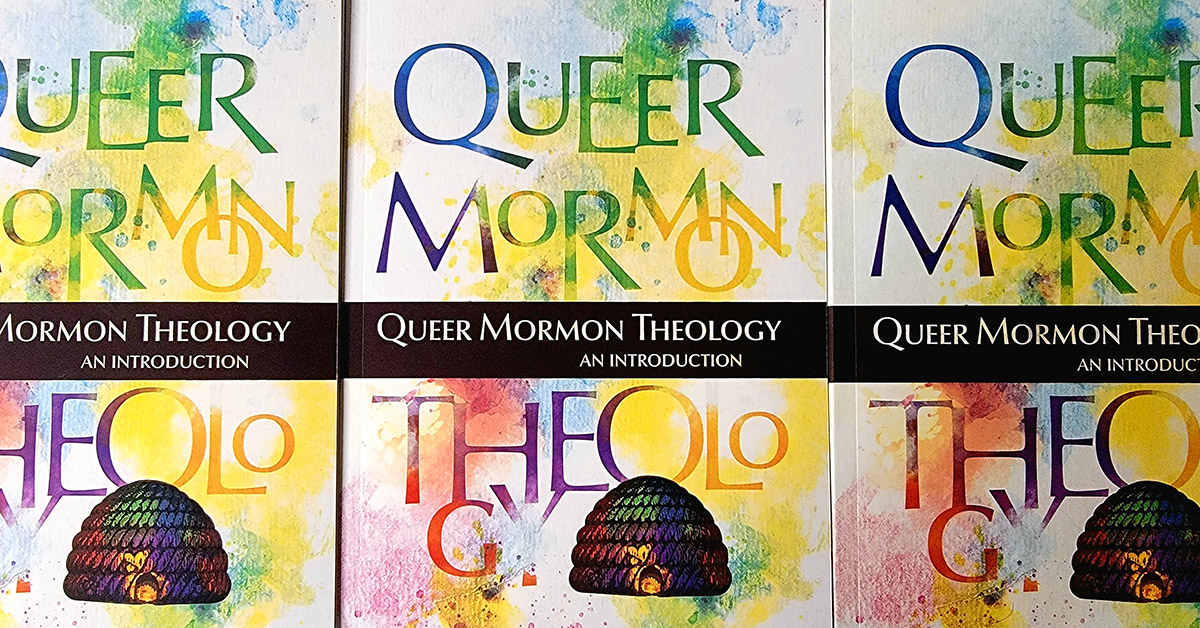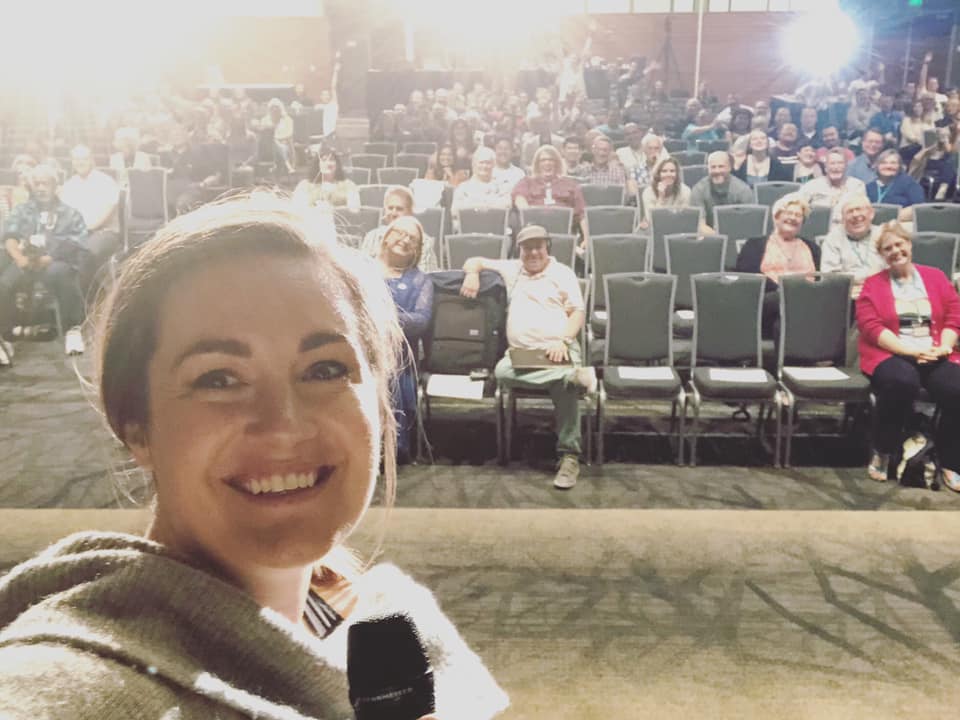Hope and Beauty in Ostler’s Queer Mormon Theology: An Introduction


by Nathan Kitchen, Affirmation President
On behalf of Affirmation, I congratulate Blaire Ostler on the publication of her book Queer Mormon Theology: An Introduction. Her book has been hotly anticipated for months now and it currently sits as the #1 new release in books about Mormonism. Over the years you have seen Blaire host our 2019 International Conference — famously taking a selfie from the stage so we could all remember our time together, interview Academy Award winner Dustin Lance Black for our 2020 International conference, and give Affirmation’s Easter fireside as a part of our AffirmationLIVE series. Blaire brings this same level of thoughtful and meaningful interpersonal connections to the pages of her new book.

Blaire Ostler takes a selfie while hosting the 2019 Affirmation International Conference in Provo, Utah.
I don’t know how I could better introduce this book than share the foreword Blaire asked me to write. It is such an honor to be trusted to occupy the space at the beginning of an author’s work and create a prelude worthy of the absolute beauty and powerful ideas in the pages that follow.
With Blaire’s permission, the foreword of Queer Mormon Theology: An Introduction:
In January of 2015, I stood in an upper room of the Brooklyn Borough Hall in New York City to see the St. Francis of Assisi exhibition. I was surrounded by beautifully illuminated, handwritten eight-hundred-year-old documents of Catholic governance and worship from the period of St. Francis.
While at the exhibit, Dr. John Edwards from St. Francis College gave a short lecture about St. Francis, the Franciscan order, and their place in church history. He taught that for two thousand years, the Catholic Church went through cycles of decline and renewal. During periods of decline, saving monastic and mendicant orders, such as the Franciscans, rose from outside the church hierarchy to lead the church away from its intimate relationship with politics and wealth, and to forsake the corrupt policies and practices that accompany such relationships.
As I left the exhibit, I reflected on our own history as a young church—our own cycles of decline and renewal, crisis and change. I specifically thought about the current crisis centering on rejecting behavior towards queer Latter-day Saints. How do we reconcile a restored theology majestically rising on the world from First Vision to King Follett—fueled by prophetic promise that “Our Heavenly Father is more liberal in his views, and boundless in his mercies and blessings, than we are ready to believe or receive”—with policies and practices rooted in prejudice, harassment, and discrimination that have structured the everyday life of queer Latter-day Saints for generations?
Much of my work as president of Affirmation: LGBTQ Mormons, Families & Friends occurs within the aftermath of such policies and practices. Affirmation confidently stands in the intersection of Queer/Latter-day Saint life and responds to the calls of our queer peers from the margins, rushing to render aid and build communities of safety, love, and hope. Our work is both immediate and practical: providing a healing and supportive community of queer mentors who not only help contextualize policies and practices, but affirm and empower each queer soul as they claim their space to confidently and authentically stand in places that feel safe and healthy for them.
From my work in the margins, it becomes clear that policies and practices have been utilized over the generations to contort and break queer bodies to fit a dominant narrative about our theology that simply isn’t true. It cannot be sustained, for that narrative only works if queer people are marginalized and erased. Why would our Heavenly Parents do that to anyone? Who are we to restrict the margins when Jesus accessed the margins?
It is here in this moment, much like St. Francis, that Blaire steps in and immediately discards the problematic dominant narrative that manages queer bodies in the church. She turns our attention to the theology of restoration and renewal that has always been with us. She lifts our chin and invites us to walk with her as she expertly shows us that in the absence of prejudice and folk tradition, there is not a significant difference between queer Mormon theology and Mormon theology.
To see queer theology hidden in plain sight, Blaire invites us all to do a hard thing. She asks those who may not identify as queer to suspend prejudices and misconceptions about sexual orientation, gender identity, and gender expression and see that the familiar theology in the Church of Jesus Christ of Latter-day Saints is inherently inclusive of our queer siblings. To those in the queer community she asks us to be a bit vulnerable and allow ourselves the grace to see the familiar theology stripped of policies and practices, where Jesus is not wiping away our queerness, but is instead the Christ who experiences queerness with us.
I can think of no one better to introduce queer Mormon theology at this moment than Blaire Ostler. She is a published poet and accomplished scholar in both the fine arts and philosophy, the kind of contemporary thinker who can skillfully connect great ideas that appear to be in conflict. Over the years, in her publications, presentations, podcasts, and personal writings, Blaire has given us a window into her brilliant mind and thoughtful philosophy. And like all great teachers, she has then invited us to expand our own horizons as we look towards self, families, community, and to the heavens.
But this is not all. To queer a familiar phrase: “Queer philosophy, if it hath not works, is dead, being alone.” Blaire couples her powerful ideas and thoughts with her work in queer spaces. For example, she is always extremely generous with her time in building queer communities, such as Affirmation and QueerMeals. She has stood outside the Conference Center with her queer peers, inviting members to stop for a moment and “Hug a Queer Mormon,” hugging so many conference goers as to lose count. Most importantly, although she would never reveal this herself, I can attest that she spends hours sitting with her queer peers, bearing burdens, and lifting the hands that hang down.
It is this combination of both philosophy and practice that makes her ideas fresh and exciting, as well as uplifting and healing. It is this combination that reveals wisdom. Therefore, her thesis that “inclusion of queer Latter-day Saints within modern orthopraxy is the natural consequence of our robust theology” is grounded in both insight and charity. This puts her in the unique position to write this book at this moment in our cycle of queer relations within the church.
Queer people have always been with us since the beginnings of the Restoration, yet until recently we have not seen them. In the church’s two-hundred-year history, queer people have continually blessed us, but we have not recognized it. And because we have not recognized them, we have not seen the spaces in our theology that queerness occupies. The hope and beauty of Blaire’s words in Queer Mormon Theology: An Introduction begin to rectify this situation in a way that not only lifts God’s queer children, but lifts us all. As you begin Blaire’s book, consider these words from a queer perspective, the end of a poem I wrote several years ago, that speak to the life-giving importance of recognizing queer Mormons in the theology of the Restoration.
We will always be with you, see us!
We continually wash upon your shores as waves,
Born to our families to bless you
When you did not realize you were in need of blessing.
And the blessing of waves shapes shorelines,
And tides bring life
To the everlasting lands
Of the Kingdom of God.